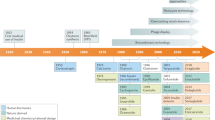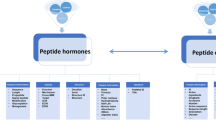Abstract
The discovery of endogenous bioactive peptides has typically required a lengthy identification process. Computer-assisted analysis of cDNA and genomic DNA sequence information can markedly shorten the process. A bioinformatic analysis of full-length, enriched human cDNA libraries searching for previously unidentified bioactive peptides resulted in the identification and characterization of two related peptides of 28 and 20 amino acids, which we designated salusin-α and salusin-β. Salusins are translated from an alternatively spliced mRNA of TOR2A, a gene encoding a protein of the torsion dystonia family. Intravenous administration of salusin-α or salusin-β to rats causes rapid, profound hypotension and bradycardia. Salusins increase intracellular Ca2+, upregulate a variety of genes and induce cell mitogenesis. Salusin-β stimulates the release of arginine-vasopressin from rat pituitary. Expression of TOR2A mRNA and its splicing into preprosalusin are ubiquitous, and immunoreactive salusin-α and salusin-β are detected in many human tissues, plasma and urine, suggesting that salusins are endocrine and/or paracrine factors.
This is a preview of subscription content, access via your institution
Access options
Subscribe to this journal
Receive 12 print issues and online access
$209.00 per year
only $17.42 per issue
Buy this article
- Purchase on Springer Link
- Instant access to full article PDF
Prices may be subject to local taxes which are calculated during checkout






Similar content being viewed by others
References
Sakurai, T. et al. Orexins and orexin receptors: a family of hypothalamic neuropeptides and G protein-coupled receptors that regulate feeding behavior. Cell 92, 573–585 (1998).
Kojima, M. et al. Ghrelin is a growth-hormone-releasing acylated peptide from stomach. Nature 402, 656–660 (1999).
Ames, R.S. et al. Human urotensin-II is a potent vasoconstrictor and agonist for the orphan receptor GPR14. Nature 401, 282–286 (1999).
Hinuma, S. et al. New neuropeptides containing carboxy-terminal RFamide and their receptor in mammals. Nat. Cell Biol. 2, 703–708 (2000).
Black, D.L. Protein diversity from alternative splicing: a challenge for bioinformatics and post-genome biology. Cell 103, 367–370 (2000).
Jung, L.J., Kreiner, T. & Scheller, R.H. Prohormone structure governs proteolytic processing and sorting in the Golgi complex. Recent Prog. Hormone Res. 48, 415–436 (1993).
Seidah, N.G. & Chretien, M. Proprotein and prohormone convertases: a family of subtilases generating diverse bioactive polypeptides. Brain Res. 848, 45–62 (1999).
Steiner, D.F. The proprotein convertases. Curr. Opin. Chem. Biol. 2, 31–39 (1998).
Eipper, B.A., Bloomquist, B.T., Husten, E.J., Milgram, S.L. & Mains, R.E. Peptidylglycine α-amidating monooxygenase and other processing enzymes in the neurointermediate pituitary. Ann. New York Acad. Sci. 680, 147–160 (1993).
Suzuki, Y., Yoshitomo-Nakagawa, K., Maruyama, K., Suyama, A. & Sugano, S. Construction and characterization of a full length-enriched and a 5′-end-enriched cDNA library. Gene 200, 149–156 (1997).
Salamov, A.A., Nishikawa, T. & Swindells, M.B. Assessing protein coding region integrity in cDNA sequencing projects. Bioinformatics 14, 384–390 (1998).
Nakai, K. & Horton, P. PSORT: a program for detecting sorting signals in proteins and predicting their subcellular localization. Trends Biochem. Sci. 24, 34–36 (1999).
Ozelius, L.J. et al. The early-onset torsion dystonia gene (DYT1) encodes an ATP-binding protein. Nat. Genet. 17, 40–48 (1997).
Ozelius, L.J. et al. The TOR1A (DYT1) gene family and its role in early onset torsion dystonia. Genomics 62, 377–384 (1999).
Hinson, J.P., Kapas, S. & Smith, D.M. Adrenomedullin, a multifunctional regulatory peptide. Endocrine Rev. 21, 138–167 (2000).
Ota, T. et al. High throughput screening of genes encoding secreted and membrane proteins in silico from full length-enriched cDNA libraries. Microb. Comp. Genomics C,87 (1988).
Shichiri, M., Kato, H., Doi, M., Marumo, F. & Hirata, Y. Induction of Max by adrenomedullin and calcitonin gene-related peptide antagonizes endothelial apoptosis. Mol. Endocrinol. 13, 1353–1363 (1999).
Shichiri, M., Yokokura, M., Marumo, F. & Hirata, Y. Endothelin-1 inhibits apoptosis of vascular smooth muscle cells induced by nitric oxide and serum deprivation via MAP kinase pathway. Arteriosclerosis Thromb. Vasc. Biol. 20, 989–997 (2000).
Ito, H. et al. Insulin-like growth factor-1 induces hypertrophy with enhanced expression of muscle specific genes in cultured rat cardiomyocytes. Circulation 87, 1715–1721 (1993).
Prouty, S.M. et al. A cell culture model system for genetic analyses of the cell cycle by targeted homologous recombination. Oncogene 8, 899–907 (1993).
Shichiri, M. & Hirata, Y. Antiangiogenesis signals by endostatin. FASEB J. 15, 1044–1053 (2001).
Shichiri, M. et al. Endothelin-1 is an autocrine/paracrine growth factor for human cancer cell lines. J. Clin. Invest. 87, 1867–1871 (1991).
Kato, H., Shichiri, M., Marumo, F. & Hirata, Y. Adrenomedullin as an autocrine/paracrine apoptosis survival factor for rat endothelial cells. Endocrinology 138, 2615–2620 (1997).
Doi, M., Shichiri, M., Katsuyama, K., Marumo, F. & Hirata, Y. Cytokine-activated p42/p44 MAP kinase is involved in inducible nitric oxide synthase gene expression independent from NF-κB activation in vascular smooth muscle cells. Hypertens. Res. 23, 643–649 (2000).
Hanson, K.D., Shichiri, M., Follansbee, M.R. & Sedivy, J.M. Effects of c-myc expression on cell cycle progression. Mol. Cell. Biol. 14, 5748–5755 (1994).
Eatman, D., Stallone, J.N., Rutecki, G.W. & Whittier, F.C. Sex differences in extracellular and intracellular calcium-mediated vascular reactivity to vasopressin in rat aorta. Eur. J. Pharmacol. 361, 207–216 (1998).
Ishimaru, S., Shichiri, M., Mineshita, S. & Hirata, Y. Role of endothelin-1/endothelin receptor system in endotoxic shock rats. Hypertens. Res. 24, 119–126 (2001).
Shichiri, M. et al. Effect of endothelin-1 on release of arginine-vasopressin from perifused rat hypothalamus. Biochem. Biophys. Res. Commun. 163, 1332–1337 (1989).
Matsushita, M. et al. Co-expression of urotensin II and its receptor (GPR14) in human cardiovascular and renal tissues. J. Hypertens. 19, 2185–2190 (2001).
Shichiri, M., Yoshinaga, K., Hisatomi, H., Sugihara, K. & Hirata, Y. Genetic and epigenetic inactivation of mitotic checkpoint genes hBUB1 and hBUBR1 and their relationship to survival. Cancer Res. 62, 13–17 (2002).
Doi, M., Shichiri, M., Yoshida, M., Marumo, F. & Hirata, Y. Suppression of integrin αv expression by endothelin-1 in vascular smooth muscle cells. Hypertens. Res. 23, 643–649 (2000).
Iwasaki, H., Sato, R., Shichiri, M. & Hirata, Y. A patient with type 1 diabetes mellitus and cerebellar ataxia associated with high titer of circulating anti-glutamic acid decarboxylase antibodies. Endocrine J. 48, 261–268 (2001).
Shichiri, M., Tanaka, A. & Hirata, Y. Intravenous gene therapy for familial hypercholesterolemia using ligand-facilitated transfer of a liposome:LDL receptor gene complex. Gene Ther. 10, 827–831 (2003).
Acknowledgements
We thank members of the Tokyo Research Laboratories and the Pharmaceutical Research Institute of Kyowa Hakko Kogyo Co. Ltd; K. Shibata and M. Koike for peptide design and synthesis; K. Sasaki for priceless comments and critical reviews; A. Yoshimatsu and S. Shirakura for studies of isolated blood vessels; K. Kurata-Miura for conventional RT-PCR; H. Kawai for sequence analysis; and A. Furuya for advice. We thank S.H. Yamaguchi and H. Yasuda for technical assistance; K. Ishizaka and H. Tanaka for surgically resected tissues; and K.D. Hanson for critical reviews and valuable feedback with constructive comments. This work was supported in part by a Grant-in-Aid for Scientific Research on Priority Areas (C) 'Medical Genome Science', and a Grant-in-Aid for Scientific Research (B) from the Ministry of Education, Culture, Sports, Science and Technology of Japan, both to M.S.
Author information
Authors and Affiliations
Corresponding author
Ethics declarations
Competing interests
The authors declare no competing financial interests.
Rights and permissions
About this article
Cite this article
Shichiri, M., Ishimaru, S., Ota, T. et al. Salusins: newly identified bioactive peptides with hemodynamic and mitogenic activities. Nat Med 9, 1166–1172 (2003). https://doi.org/10.1038/nm913
Received:
Accepted:
Published:
Issue Date:
DOI: https://doi.org/10.1038/nm913
This article is cited by
-
Downregulation of salusins alleviates hypertrophic cardiomyopathy via attenuating oxidative stress and autophagy
European Journal of Medical Research (2024)
-
Serum salusin-α and -β levels in patients with parkinson’s disease
Neurological Sciences (2024)
-
Serum salusin-β levels in patients with systemic lupus erythematosus
Clinical Rheumatology (2023)
-
The role of serum salusin alpha and beta levels and atherosclerotic risk factors in idiopathic sudden hearing loss pathogenesis
European Archives of Oto-Rhino-Laryngology (2022)
-
GIP_HUMAN[22–51] is a new proatherogenic peptide identified by native plasma peptidomics
Scientific Reports (2021)



